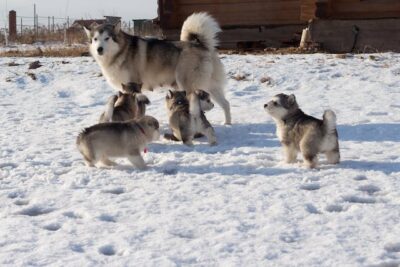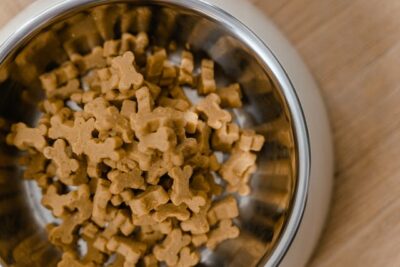Overview
Introduction: How Many Puppies Can A Dog Have

If you’ve ever wondered how many puppies a dog can have or what factors influence the size of a canine litter, you’re in the right place. Canine reproduction is a fascinating subject that involves a combination of genetics, biology, and responsible breeding practices.
In this article, we will delve into the intricacies of canine litter size, how many puppies can a dog have, from the factors that affect it to the ethical considerations surrounding breeding. So, let’s embark on this journey to uncover the mysteries of canine litters.
The Wonder of Canine Reproduction
Canine reproduction is a remarkable process that has captivated humans for centuries. Dogs, like many other animals, have their unique reproductive cycle and behaviors that make them a subject of interest and study.
Exploring the Importance of Grasping Litter Size: How Many Puppies Are Involved?
Understanding canine litter size is not only a matter of curiosity but also of practical importance. Whether you are a dog owner, breeder, or simply an enthusiast, knowing what influences litter size can help you make informed decisions and ensure the well-being of both mother and puppies.

How Many Puppies? Factors Influencing Litter Size
Canine litter size can vary significantly from one dog to another, and several factors come into play. Understanding these factors is essential for pet owners and breeders alike. Let’s delve deeper into the intricacies of what determines how many puppies a dog can have.
Breed Variability
Different dog breeds exhibit variations in litter size. Some breeds are known for having larger litters, while others tend to have smaller ones. The genetic makeup of a breed can influence the potential litter size. For instance, larger breed dogs like Great Danes or Bernese Mountain Dogs often have larger litters, ranging from 8 to 12 puppies on average.
In contrast, smaller breeds like Chihuahuas or Pomeranians typically have smaller litters, with an average of 1 to 4 puppies per litter. Understanding the breed’s tendencies is crucial for both breeders and prospective pet owners, as it helps set realistic expectations.
Maternal Age
The age of the mother dog can significantly influence the size of her litter. Younger female dogs, in their prime reproductive years, often have larger litters. As a female dog ages, her ability to produce larger litters may decline.
This is why breeders often aim to breed dogs during their optimal reproductive years to maximize litter size. However, it’s essential to note that individual variations exist, and older dogs can still have healthy litters.

Health and Nutrition
The health and nutritional status of the mother dog play a crucial role in determining the number of puppies in a litter.
Proper healthcare, including regular veterinary check-ups, vaccinations, and prenatal care, is essential to ensure the mother’s well-being and, consequently, the health of her puppies.
Additionally, a well-balanced diet rich in essential nutrients is vital for both the mother’s health and the development of the growing fetuses. Ensuring the mother dog receives proper nutrition during pregnancy contributes to larger, healthier litters.
The Biological Process of Pregnancy
To understand litter size, we must first grasp the stages of canine pregnancy. Let’s break down the biological process:
The Canine Reproductive Cycle
The female dog, also known as a bitch, goes through a unique reproductive cycle known as the heat cycle. This cycle is a fundamental aspect of understanding how many puppies can a dog have. We’ll explain the different stages and their significance.
Fertilization and Implantation
Once the female dog is in heat, fertilization can occur if she mates with a male dog. We’ll delve into how fertilization takes place and how the fertilized eggs implant in the mother’s uterus, setting the stage for dog’s pregnancy. This implantation process plays a pivotal role in determining the number of puppies in a litter.
Gestation Period
The duration of pregnancy in dogs, also known as the gestation period, varies between breeds. Smaller dog breeds tend to have shorter gestation periods, whereas larger breeds may carry their puppies for a more extended period. We’ll discuss the average litter size, including golden retriever litters and other breeds, and what happens during this time.

The Role of Genetics
Genetics plays a crucial role in determining dog’s litter size. Let’s delve into the genetic factors at play:
Inherited Traits and How Many Puppies
Certain genetic traits can influence the number of puppies a dog can have. Some breeds are genetically predisposed to have larger litters, while others consistently produce smaller litters.
We’ll explore these traits and their inheritance, shedding light on the average number of puppies in various breeds.
The Impact of Male Genetics
It’s not just the mother’s genetics that matter. The parent’s genetics can also affect litter size significantly. Understanding how male dog genetics contribute to the number of puppies in a litter is essential for breeders and dog owners alike.
Breeding for Litter Sizes
Breeders often aim to produce litters of a specific size based on the desired characteristics of their breeding program. We’ll discuss the breeding practices that many breeders employ to achieve their desired litter size, whether they aim for smaller, more manageable litters or larger, show-quality ones.

Breeding Practices and Litter Management
Responsible breeding practices and proper litter management are essential for the health of both the mother dog and her puppies. Let’s explore these practices:
Responsible Breeding Guidelines
Ethical and responsible breeders adhere to specific guidelines to ensure the well-being of their dogs and the puppies they produce. These guidelines help maintain the genetic diversity of the breed while ensuring that litters are healthy and free from congenital defects.
Artificial Insemination and Its Influence
Artificial insemination is a technique used in dog breeding to improve the chances of successful fertilization. We’ll discuss how this technology can influence litter size and the success of breeding programs.
Monitoring the Dog’s Pregnancy
Regular monitoring of a pregnant dog is crucial to ensure that both the mother and her developing puppies are healthy. Veterinarians and most breeders closely track the pregnancy’s progress, addressing any potential issues promptly.

Canine Litter Size Records
Exploring the Spectrum of Canine Reproduction
In addition to examining historical canine litter size records, let’s broaden our perspective by delving into the diverse landscape of canine reproduction.
Understanding the variations in litter size is a captivating journey that involves exploring the factors influencing the reproductive capacities of most female dogs.
Unlocking the Secrets of More Puppies
Some dog breeds, especially large breed dogs, have earned a reputation for producing more puppies in each litter. Delving into the nuances of their genetics and reproductive cycles, we uncover the fascinating stories behind these extraordinary canine families.
From the beloved golden retriever with its consistent larger litter sizes to the impressive giant breeds boasting above-average litter sizes, we’ll unravel the mysteries of why certain breeds tend to have more puppies.
Decoding Large Breed Dogs and Average Litter Sizes
The intrigue deepens as we focus on large breed dogs and their impact on the average litter sizes. Whether it’s the gentle giant, the Neapolitan Mastiff, known for its potential to yield large litters, or other breeds within the spectrum of large breeds, understanding their reproductive tendencies sheds light on the impressive variability within the canine world.
Glimpses into Golden Retriever Litters
The golden retriever, a beloved and popular breed, often stands out for its consistently above-average litter sizes. Exploring the factors that contribute to their larger litters provides valuable insights into the breed’s genetic makeup and the intricacies of their reproductive success.
Case Studies Unveiling Giant Breeds and Large Litter Dynamics
Specific case studies involving giant breeds offer a closer look at the interplay of genetics, breeding practices, and other factors contributing to large litter sizes.
By analyzing these cases, we gain a deeper understanding of why certain giant breeds consistently surpass the average litter sizes, unraveling the complexity of canine reproduction in the context of giant breeds.

Common Misconceptions
There are several misconceptions about canine litter size that we need to debunk:
Small Dogs, Small Litters?
Contrary to common belief, the size of a dog doesn’t necessarily dictate the size of her litters. Smaller dog breeds can have surprisingly large litters, while larger breeds might have smaller ones.
The Myth of First-Time Litters
The idea that first-time mothers produce smaller litters is a myth. We’ll separate fact from fiction and explain why the mother dog’s experience isn’t the sole determinant of litter size.
Litter Size and Motherly Care
Does the size of a litter impact the mother dog’s ability to care for her puppies? We’ll explore this question, emphasizing that mother dogs are typically equipped to nurture their offspring, regardless of litter size.
Maximizing Litter Health
Ensuring the health of both the mother dog and her puppies is paramount. Let’s discuss how to achieve this:
Neonatal Care for Puppies
Newborn puppies require special care to thrive. We’ll provide essential guidance on how to provide the best care for these delicate little ones, promoting their growth and development.
Vaccinations and Health Measures
We’ll discuss the importance of vaccinations and other health measures to protect the puppies’ well-being. This includes preventive measures against common health issues and ensuring that puppies are off to a healthy start in life.

Ethical Considerations
Responsible breeding goes hand in hand with ethical considerations. Let’s delve into these important ethical aspects:
Consequences of Overbreeding and the Imperative for Responsible Breeding
The repercussions of overbreeding extend beyond the mere production of puppies. Both the mother and the offspring face potential health issues, resulting in a diminished quality of life.
This discussion delves into the risks associated with overbreeding and underscores the significance of responsible breeding practices.
Breeders’ Obligations and the Ethical Dimension
Examining the responsibilities of breeders reveals a critical role in ensuring the well-being of dogs and their puppies. Ethical obligations take center stage, emphasizing the importance of adhering to ethical practices throughout a dog’s life, especially in contexts where puppy mills, purebred dogs, larger dogs, smaller dogs, and litters typically ranging in size are factors that need careful consideration.
Adoption vs. Purchasing Puppies
The choice between adopting a dog or purchasing a puppy is a significant ethical consideration for potential pet owners. We’ll weigh the pros and cons of each option, helping individuals make informed decisions aligned with their values.
Implications for Dog Owners
What does this knowledge mean for dog owners? Understanding the factors that influence how many puppies can a dog have can empower owners to make informed decisions about breeding, spaying, or neutering their pets, and providing the best care for their canine companions.
It also highlights the significance of regular veterinary check-ups and responsible pet ownership.
Frequently Asked Questions (FAQs)
How many puppies can a dog have on average?
- The average litter size for dogs varies widely, but it typically falls between 1 and 12 puppies. Smaller breeds tend to have smaller litters, while larger breeds may have more puppies.
Are there specific dog breeds known for having larger litters?
- Yes, certain dog breeds are known for having larger litters. Breeds like Golden Retrievers, Great Danes, Neapolitan mastiff, and Labrador Retrievers often have larger litter sizes compared to smaller breeds.
What factors influence the litter size of a dog?
- Several factors can influence a dog’s litter size, including the dog’s breed, age, overall health, and genetics. Responsible breeding practices and the mother’s well-being are also essential.
Can a dog have more puppies in subsequent litters?
- It’s possible for a female dog to have different litter sizes in different pregnancies. However, age, health, and breed can still play a role in these variations.
What is considered a healthy litter size?
- A healthy litter size depends on the breed and the individual dog. It’s essential to prioritize the health and well-being of both the mother dog and her puppies rather than aiming for a specific number.
Are there any health concerns associated with larger litters?
- Yes, larger litters can pose health risks for both the mother and the puppies. Adequate prenatal care and monitoring are crucial to mitigate these risks.
What can I do to ensure a safe and successful pregnancy for my dog?
- To ensure a safe and successful pregnancy, provide your dog with proper nutrition, regular veterinary check-ups, a clean and comfortable whelping environment, and plenty of care and attention.
Is there a limit to how many litters a dog can have in her lifetime?
- There is no strict limit, but responsible breeders prioritize the health and well-being of their dogs. Breeding a dog too frequently can lead to health issues and should be avoided.
What role does the male dog play in determining litter size?
- The male dog’s genetics also influence litter size. Some male dogs may carry genes that contribute to larger or smaller litters.
How can I find a reputable breeder who prioritizes the health of the dogs and their litters?
- Look for breeders who are members of reputable breed clubs, follow ethical breeding practices, and prioritize the health and well-being of their dogs. Ask for references and visit their facilities if possible.
Are certain dog breeds more prone to having smaller litter?
- Yes, some dog breeds are known for typically having smaller litters. Breeds like Chihuahuas and Yorkshire Terriers often have fewer puppies per litter due to their small size.
Can a dog’s age impact the number of puppies in a litter?
- Yes, a dog’s age can influence litter size. Younger dogs may have smaller litters in their first pregnancies, while older dogs might have larger or smaller litters in subsequent pregnancies.
How can I help my pregnant dog during the whelping process?
- To assist your pregnant dog during whelping, it’s essential to be prepared. Provide a quiet and safe birthing environment, have the necessary supplies on hand, and be ready to call a veterinarian in case of complications.
Is it common for dogs to have two litters or more in a year?
- While it’s possible for a dog to have multiple litters in a year, responsible breeders typically allow sufficient time between litters to ensure the mother’s health and well-being.
What are the signs that a pregnant dog is nearing labor?
- Signs that a pregnant dog is nearing labor include restlessness, nesting behavior, a drop in body temperature, and the onset of contractions. It’s essential to monitor your dog closely during this time.
What is the role of genetic diversity in a dog’s litter size?
- Genetic diversity can influence the variability in litter size within a breed. Maintaining genetic diversity is essential to prevent issues associated with excessive inbreeding.
Are there any special considerations for miniature breeds regarding litter size?
- Miniature dog breeds may have unique considerations when it comes to litter size due to their smaller size. It’s essential to monitor their pregnancies closely and provide appropriate care.
Conclusion

In conclusion, this comprehensive guide has unraveled the mysteries of litter size in dogs, providing valuable insights into the factors that influence it, from genetics and breeding practices to ethical considerations. For more in-depth information and resources on responsible breeding and canine reproduction, visit our blog.
It’s our hope that this knowledge empowers breeders to produce healthy puppies and encourages responsible pet ownership. As we celebrate the beauty of canine reproduction, let’s ensure that the welfare of our furry friends remains a top priority.




